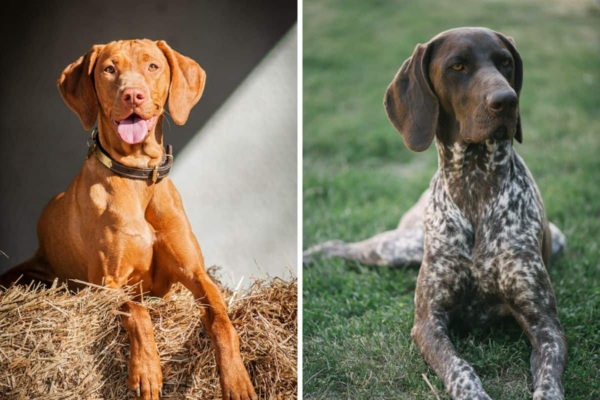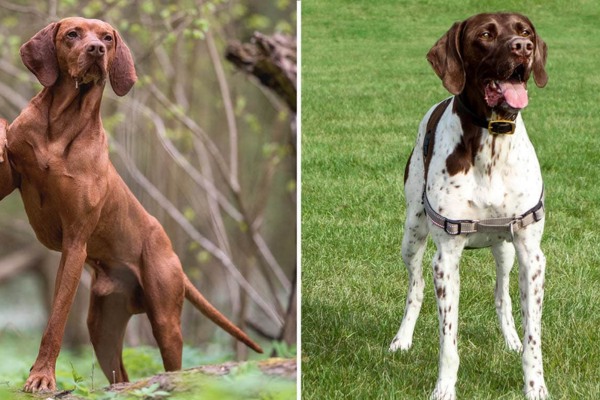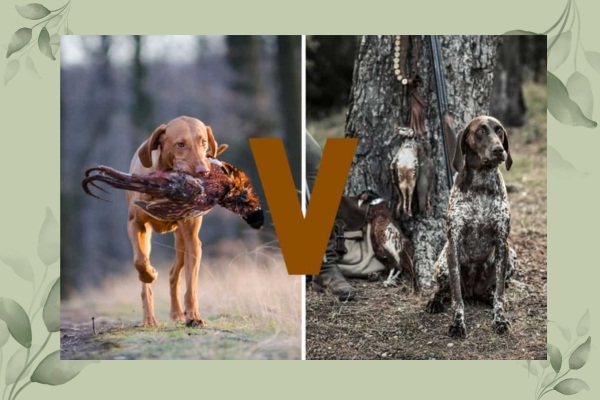The Vizsla and German comparing their breed histories, physical characteristics, temperament, personality traits, and hunting skills and abilities. You’ve been considering adding a furry friend to your household for some time now, and you’ve narrowed down your options to two breeds the Vizsla and German Shorthaired Pointer
Both breeds are known for hunting skills and make great companions for active individuals or families.
But which one is right for you?
By the end of this article, you’ll better understand each breed’s unique qualities and be able to decide which furry companion will best suit your lifestyle.
Key Takeaways
- Vizsla and German, Shorthaired Pointer breeds are known for their hunting skills and make great companions for active individuals or families.
- Vizslas originated in Hungary during the Middle Ages, while German Shorthaired Pointers were created in Germany during the late 19th century.
- Both breeds have an overall athletic appearance with muscular bodies built for agility and endurance, weigh between 45-65 pounds, and stand around 21-25 inches tall at the shoulder.
- Vizslas tend to be more sensitive and affectionate. At the same time, German Shorthaired Pointers are generally more outgoing and independent thinkers who enjoy spending time outdoors and participating in activities such as hunting or agility training.
Breed History and Origins Vizsla Vs German
You may wonder where the Vizsla and German shorthaired pointer breeds come from and how they developed into the dogs we know today. Both species have a rich history, with evolutionary development dating back centuries.
The vizsla breed originated in Hungary during the Middle Ages, where the Hungarian nobility used them as hunting dogs. These dogs were highly valued for their excellent sense of smell, speed, and agility when hunting game birds. Vizslas played an essential role in the country’s cultural significance as a symbol of wealth and power.

On the other hand, German shorthaired pointers were created in Germany during the late 19th century by crossing various hunting dog breeds like English pointers, bloodhounds, and foxhounds. The result was an all-purpose gun dog that could hunt game on land or water with equal proficiency. Their popularity increased in Europe and America due to their versatility and intelligence.
Both vizslas and German shorthaired pointers have unique histories that make them stand out among other dog breeds. Whether you prefer a loyal companion or a skilled hunter, understanding these breeds’ origins can help you appreciate their incredible abilities even more.
So, if you’re looking for a furry friend that will stay by your side through thick and thin or one that will help you bring home dinner, either way, you can’t go wrong with choosing between these two fantastic dog breeds!
Physical Characteristics
Regarding physical characteristics, you’ll find that the size and weight of both vizslas and German shorthaired pointers are similar. Both breeds typically weigh 45-65 pounds and stand around 21-25 inches tall at the shoulder.
In terms of coat and color, they differ slightly – vizslas have short, smooth skin that ranges in shades from golden rust to coppery red, while German shorthaired pointers have a thicker coat with a mix of colors including liver, black, or white with liver or black markings.
Despite these differences, both breeds boast an overall athletic appearance with muscular bodies built for agility and endurance.
Size and Weight
If you’re looking for a dog that’s not too big or too small, the Vizsla and German shorthaired pointer are coincidentally similar in size and weight.
These two breeds share a medium build and height, with the Vizsla measuring between 21 to 24 inches tall and weighing between 45 to 65 pounds, while the German shorthaired pointer measures between 21 to 25 inches tall and weighs between 45 to 70 pounds. Because of their size, these dogs can quickly adapt to different living environments, whether it’s an apartment or a house with a yard.

However, keep their similar size from fooling you into thinking they are low-energy dogs. Both breeds have high exercise requirements and activity levels that need to be met in order for them to stay happy and healthy.
The Vizsla is known for its boundless energy and loves running outdoors all day long. On the other hand, the German shorthaired pointer is also very active but can handle rough terrain better than most dogs, thanks to its sturdy build.
If you’re up for daily walks or runs in the park with your furry friend, then either of these breeds would make excellent companions for you!
Coat and Color
Get ready to fall in love with these beautiful and unique Vizsla and German Shorthaired Pointer coat colors. The Vizsla comes in various colors, including golden rust, russet gold, and dark sandy yellow. On the other hand, German Shorthaired Pointers come in solid liver-colored or liver and white spotted coats. Both breeds have short coats that require minimal grooming.
To give you a better idea of the color variations between these two breeds, take a look at the table below:
- Breed Color Variations
- Vizsla Golden rust, Russet gold, Dark Sandy Yellow
- German Shorthaired Pointer Solid Liver-Colored or Liver & White Spotted
Regular brushing is necessary to keep their short coats looking smooth and shiny when it comes to grooming techniques for these two breeds. However, you may need a de-shedding tool to remove any loose fur more efficiently during the shedding season. Overall, whether you prefer the warm tones of the Vizsla’s coat or the spotted patterns of the German Shorthaired Pointer’s coat, both breeds are easy to maintain and sure to steal your heart!
Overall Appearance
The overall appearance of these breeds will leave you in awe with their sleek and athletic bodies that exude grace and power.
The Vizsla is a medium-sized dog with a lean but muscular build. Their coat is short and dense, highlighting their well-defined muscles. They have long, narrow heads with expressive eyes that give them an alert and intelligent look.
On the other hand, the German Shorthaired Pointer has a slightly larger frame than the Vizsla but still retains its athleticism. Their coat is also short but can come in different colors ranging from liver to black to white or combinations of these colors. They have a broad head with floppy ears that make them look friendly and approachable.
Both breeds have strong legs that allow them to move quickly on land and even swim effortlessly in water. Both species embody strength, agility, and elegance through facial features and body structure.
Temperament and Personality
Discovering the personality differences between vizslas and German shorthaired pointers can help you choose the perfect companion for your lifestyle. Both breeds require early socialization to prevent behavioral issues later on. Vizslas tend to be more sensitive and may become anxious or fearful if not correctly socialized, while German shorthaired pointers are generally more outgoing and friendly.
Behavioral differences also play a role in choosing between these two breeds. Vizslas are known for being affectionate and loyal, often referred to as ‘velcro dogs’ because they always desire to be close to their owners. They thrive on human interaction and may struggle with separation anxiety if left alone for long periods.
On the other hand, German shorthaired pointers are independent thinkers who enjoy spending time outdoors and participating in activities such as hunting or agility training. Lastly, it’s essential to consider your personality when deciding between a Vizsla and a German shorthaired pointer. If you’re looking for a dog that wants nothing more than to cuddle up with you on the couch, a Vizsla may be the better choice.
However, if you lead an active lifestyle and want a dog that can keep up with you on hikes or runs, a German shorthaired pointer might be the way to go. Ultimately, both breeds make great companions but have distinct personalities to consider before deciding.
Hunting Skills and Abilities
To truly understand which breed best suits your hunting needs, consider their respective skills and abilities. The Vizsla and the German Shorthaired Pointer are known for their hunting prowess but have different techniques for tracking and capturing prey.
The Vizsla is a natural pointer with an excellent sense of smell. They are known to track the game by scenting the ground and then pointing towards its location. They are also skilled at flushing out birds from bushes or trees, making them an ideal choice for bird hunters. Additionally, Vizslas possess great stamina, which allows them to keep up with their owners on long hunts.

On the other hand, the German Shorthaired Pointer has a versatile hunting style that includes both pointing and retrieving. They have been used for hunting various game, including birds, rabbits, and even deer. Their prey preferences tend towards larger animals than those preferred by Vizslas. Their ability to retrieve prey from water bodies sets them apart from other breeds – they excel as waterfowl retrievers.
While both breeds are skilled hunters in their own right, they differ in tracking techniques and prey preferences. Consider your specific hunting needs before choosing between a Vizsla or a German Shorthaired Pointer as your companion on your next hunt.
Training and Care
It would be best to prepare for the task when training and caring for your hunting companion. Training your Vizsla or German Shorthaired Pointer is crucial in ensuring they are well-behaved when out on the hunt.
Positive reinforcement is critical in training both breeds, as they respond well to praise and treats. Use a gentle yet firm hand when teaching them basic commands and reward them for good behavior.
Socialization is also an essential aspect of caring for your hunting companion. Give your dog plenty of opportunities to interact with other dogs and people from a young age. This will help them become more comfortable around unfamiliar situations and prevent aggression towards others.
In addition to training, keeping your Vizsla or German Shorthaired Pointer healthy requires regular exercise, a balanced diet, and routine check-ups with a veterinarian. Ensure they get enough physical activity daily by taking them on walks or runs, playing fetch, or engaging in other outdoor activities. Proper nutrition is also essential – feed them high-quality food that meets their nutritional needs.
Your hunting companion will be happy, healthy, and ready to perform their best in the field with proper care and attention.
See Also:
- Top Dog Breeds For Families: Best Buddies For Kids!
- How Many Dog Breeds Are There?
- Tiktok Vet Reveals Top 5 Dog Breeds For Owners
- Unique Dog Breeds
Conclusion
So, you’ve learned about the Vizsla and German Shorthaired Pointer breeds. Both have unique qualities, making them excellent hunting companions and loyal family pets.
The Vizsla’s origin in Hungary and its sleek, rust-colored coat make it stand out, while the German Shorthaired Pointer’s versatility and athleticism set it apart.
Regarding temperament, both breeds are affectionate with their families but can be reserved with strangers. They require plenty of exercise and training to keep their minds stimulated. However, the German Shorthaired Pointer might be the better choice if you’re looking for a breed more adaptable to different environments and tasks.
In conclusion, whether you choose a Vizsla or a German Shorthaired Pointer as your furry companion will depend on your lifestyle and preferences. But one thing is sure: these breeds are full of energy and love that will bring joy to your life.
As they say, “A dog is the only thing on earth that loves you more than he loves himself.
If you can’t find the right dog for you to adopt locally, please consider adopting a dog from Bone Voyage Dog Rescue. We’ll fly with your dog to you.
Frequently Asked Questions
Which breed is better for families with children?
As a family, you want a breed that’s not just lovable but also low-maintenance. Vizslas are affectionate, and GSPs are energetic. Both need minimal grooming, making them perfect for busy parents.
Are vizslas or German shorthaired pointers more prone to specific health issues?
When considering a breed, knowing their common health problems and preventative care is essential. Breeding considerations and genetic testing can also help reduce the risk of hereditary diseases. Stay informed and proactive about your furry family member’s health.
How do these breeds differ in terms of energy level and exercise requirements?
Consider breeds like the Vizsla or German Shorthaired Pointer if you’re looking for a high-energy dog. They thrive on frequent exercise and have natural hunting instincts that can be channeled into trainable obedience. High-intensity activities like running or hiking suit them best, but they also enjoy steady-state exercise like long walks.
Which breed tends to be more vocal or prone to barking?
Oh, you want a dog that won’t bark excessively? Well, good luck with that. However, Vizslas and German Shorthaired Pointers can be trained to bark less through proper training techniques and managing excessive barking.
Can these breeds be trained for purposes other than hunting?
Regarding training challenges, both breeds have high energy levels and require consistent exercise. However, they excel in non-hunting activities such as agility, obedience, and therapy work. With patience and dedication, these versatile dogs can learn various skills beyond hunting.
